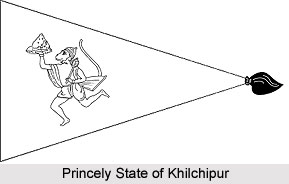 The Princely State of Khilchipur was one of the renowned states under the rule of the British Empire in India which was managed by native rulers or Indian princes under the indirect control of the British Government of India. The native ruler of the state had autonomous power to administer the internal issues of the state. But they maintained pleasant association with the British as they received protection and security in return. During the rule of the British administration in the country, Khilchipur was appointed as a princely state which was under the Bhopal Agency of Central India Agency. The princely state of Khilchipur was headquartered in Khilchipur. At present the region is a Nagar Panchayat and a town in the district of Rajgarh in Madhya Pradesh state, India.
The Princely State of Khilchipur was one of the renowned states under the rule of the British Empire in India which was managed by native rulers or Indian princes under the indirect control of the British Government of India. The native ruler of the state had autonomous power to administer the internal issues of the state. But they maintained pleasant association with the British as they received protection and security in return. During the rule of the British administration in the country, Khilchipur was appointed as a princely state which was under the Bhopal Agency of Central India Agency. The princely state of Khilchipur was headquartered in Khilchipur. At present the region is a Nagar Panchayat and a town in the district of Rajgarh in Madhya Pradesh state, India.
History of Princely State of Khilchipur
The Princely State of Khilchipur was established by a Khichi Rajput named Dewan Ugra Sen in 1544. He was compelled by family dissensions to migrate from the Khichi capital of Gagraun. The Khichi Rajputs were a division of the great Chauhan dynasty. The Mughal Emperor at the time made a subsequent grant of land to him, as a result of his loyal services. The land included the neighboring regions of Zirapur and Machalpur parganas; later parts of princely state of Indore, Shujalpur and princely state of Gwalior were also included in the territory. The princely state had its capital in the town of Khilchipur. The territory covered a total area of 710 sq km and the total population of the state in the year 1901 was 31,143. The Khichi Rajputs of the Chauhan clan were the native rulers of the state. The rulers of the Khilchipur state paid a yearly tribute to Scindia of Gwalior.
After the withdrawal of the British Government and the Indian Independence in the year 1947, the rulers acceded the princely state of Khilchipur to the newly formed Union of India, also known as the Dominion of India. The state was incorporated as the rulers acceded to the new Madhya Bharat state or Malwa Union, which was formed on 28th May 1948. It was created from 25 former princely state of India that was under the erstwhile Central India Agency. Later on 1st November 1956, Madhya Bharat was merged with Madhya Pradesh.



















